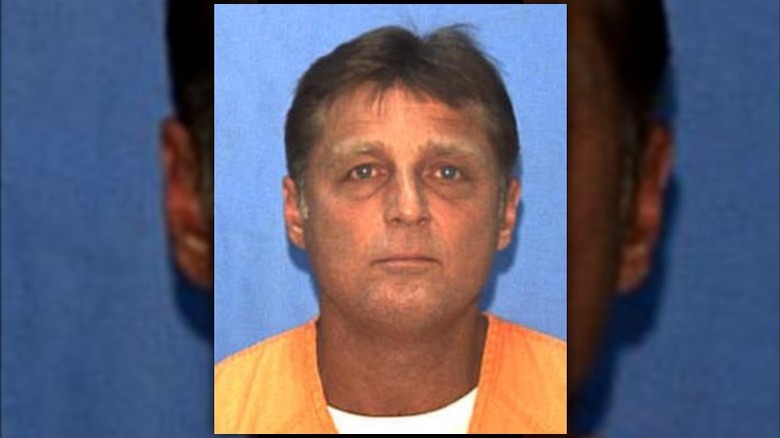Grim Details On The Killer Who Reportedly Confessed To Nicole Brown Simpson's Murder
Warning: The following article includes descriptions of child abuse and sexual assault.
The 1995 trial of former NFL star O.J. Simpson for the murder of his ex-wife, Nicole Brown Simpson, and her friend, Ron Goldman, captivated America. The case has also lingered long in the collective memory thanks to the shocking climax of the proceedings — the jury acquitted Simpson of both murders despite what experts believed was ample evidence to the contrary. America was divided as to whether they believed justice had been done.
As the years have passed, a greater and greater proportion of Americans have come to believe that the jury in the Simpson case was wrong and that he was indeed guilty of the double murder. Others still fixate on one question: If Simpson didn't kill the two victims, then who did? After being found not guilty, the actor claimed he would dedicate his life to finding the killer, a promise he didn't make any public attempt to fulfill, which critics took as further proof of his guilt. Nevertheless, in the years since the Brown Simpson and Goldman murders various alternative theories have emerged about the case.
A niche group believes that Nicole Brown Simpson and Ron Goldman were the victims of a serial killer named Glen Edward Rogers, who was active during the 1990s and reportedly confessed to the crime. Dubbed "The Casanova Killer" or "The Cross-Country Killer" by true crime aficionados, Rogers' story is deeply disturbing. Indeed, his supposed confession has added fuel to the debate around one of the most notorious crimes in living memory.
A brutal early life
According to the FBI, most serial killers commit their first crimes in adulthood, having, in some cases — such as that of Jeffrey Dahmer — developed a fascination with animal cruelty. The story of Glen Edward Rogers, however, is different. Born in Hamilton, Ohio, in 1962, as the last of the family's seven children, Rogers suffered a traumatic birth and various injuries as a child. He was reportedly terrorized by his mother, Edna, who was violent and neglectful toward him and kept him in restraints from the age of 3. Anytime he could break free, he would allegedly eat the paint on the walls of the room he was abandoned in.
Edna also submerged Rogers' head underwater during bath time, at one time almost killing him (and interestingly, two of his victims were reportedly murdered in bathtubs). On one occasion, she threatened to drive the entire family off a cliff while behind the wheel of the car. At 13, Rogers reportedly attempted suicide after finding naked photographs of his mother.
Rogers was introduced to drugs at the age of 12 through his older brother Clay and began to experience addiction. The two soon became partners in burglary, and Rogers was regularly sent to juvenile detention centers. In the 2012 documentary "My Brother the Serial Killer," Clay said it was during this time his brother was sexually abused. By the time he was an adult, Rogers had become a heavy drinker and frequent cocaine user and was arrested regularly for public intoxication and drunk driving. He was once hospitalized after injecting himself with Budweiser.
He believed he had killed as a child
It is believed that Glen Edward Rogers developed severe anger issues as a result of his childhood, but one incident in particular might have sparked his transformation into a serial murderer. In a letter written to criminal profiler Anthony Meoli, who was in contact with Rogers after his apprehension and imprisonment, Rogers claimed that at around age 13, he routinely witnessed his father going to the basement of the family home with sex workers. On one occasion, Rogers said he began to argue with a woman his father had brought home after she made a comment about his mother, and he pushed her down the stairs.
Rogers' father, who was still in the basement, shouted that the boy had killed her and that they had to hide the evidence of the death. The killer recalled that he and his father gathered the body up and drove to Kentucky, where they dumped her remains. Rogers said that his father's impelling him to keep the crime quiet was the first conversation the two of them had ever had. In the aftermath of the killing, his father reportedly distanced himself again from his son, and the boy's anger grew.
He was a frenzied attacker
Commentators have said that Glen Rogers' relationship with his mother may have underpinned his crimes, which involved frenzied attacks on women with light-color hair — just like Edna. He was first arrested at 15 years old. By the time he was a young man, Glen Edwards Rogers was full of rage and prone to explosions of anger. He was also superficially handsome and charming, which made him especially dangerous to the women he encountered on his frequent visits to bars.
At 18, he married a sex worker named Debbie, whom he had known since she was 13 and who, the year previous, had given birth to another man's child. Rogers adopted the baby, and the pair had another before the marriage abruptly ended. He discovered Debbie was having an affair, so he beat and kicked her wearing a pair of steel toe boots so violently that she required corrective surgery. Rogers' violence against women included an attack on his own mother, whom he witnessed on a date with a man other than his father, and later sexual assaults.
Rogers was arrested after a high-speed chase
The arrest of Glen Edward Rogers in November 1995 made headline news. By then, he had been linked to the deaths of four women in California, Mississippi, Florida, and Louisiana. At the time, he was the subject of a high-profile manhunt, and eventually his cousins informed police that they had received a visit from the killer in Kentucky. The hunt climaxed with a 100 mph police chase, with Rogers drunk behind the wheel.
The women Rogers was accused of killing had reddish hair and were in their mid-30s. He had met several of them in bars and attacked them viciously in a drunken stupor. However, Rogers is also believed to be responsible for many more murders, including that of his 71-year-old roommate, Mark Peters, who had taken him in. Though Rogers pleaded his innocence during his trial, he allegedly bragged about killing 70 people at the time of his arrest. Reports claim he later recanted.
His confession has turned heads
Glen Rogers was sentenced to death on July 11, 1997, in Tampa, Florida, having been found guilty of the murder of Tina Marie Cribbs. The following year, the murderer was extradited to California, where he was put on trial for the slaying of Sandra Gallagher and once again found guilty, receiving a second death sentence. Since then, he has remained on death row, and both law enforcement and true crime enthusiasts have maintained an interest in the serial killer, speculating on how many murders he may have committed before he was caught.
In recent years, attention has turned to Rogers' potential connection to Nicole Brown Simpson. In the 2012 documentary "My Brother the Serial Killer," Rogers' sister Sue said the killer had met Brown Simpson while in Los Angeles, and the pair had grown close. Elsewhere in the movie, Clay claimed that he received a phone call from his brother in which he made a direct threat about "taking her down" for her money. According to the documentary, Rogers later admitted to the killings in his correspondence with Anthony Meoli and claimed O.J. Simpson paid him to rob Brown Simpson's home — and kill her if necessary. Clay has stated that he believes Rogers is behind the slayings.
Though the story of Rogers' confession generated a flurry of headlines following the release of the flick, it remains a fringe theory in the Brown Simpson and Goldman murder case. The families of Brown Simpson and Ron Goldman reacted angrily to the show, with Brown Simpson's sister Denise dismissing it as a publicity stunt. Although the LAPD promised to investigate these claims in 2012, to date they have never released a public statement regarding the results of their investigation.
If you or anyone you know needs help with addiction issues, help is available. Visit the Substance Abuse and Mental Health Services Administration website or contact SAMHSA's National Helpline at 1-800-662-HELP (4357).
If you or someone you know may be the victim of child abuse, please contact the Childhelp National Child Abuse Hotline at 1-800-4-A-Child (1-800-422-4453) or contact their live chat services.
If you or anyone you know has been a victim of sexual assault, help is available. Visit the Rape, Abuse & Incest National Network website or contact RAINN's National Helpline at 1-800-656-HOPE (4673).




